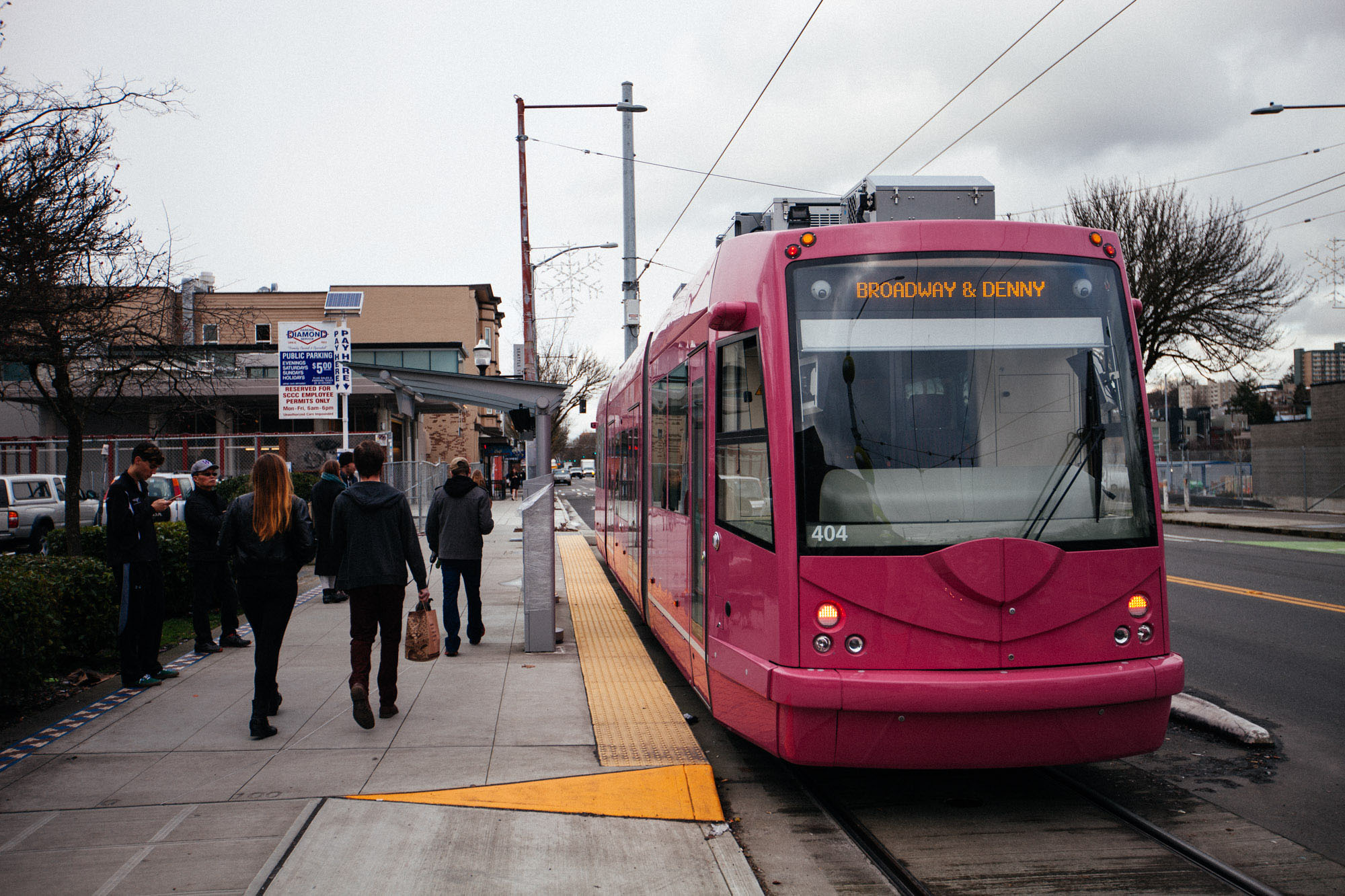After a long day in the U-District last week, I got off the bus at Seattle Central and started walking in the rain back to campus. Luckily, as I approached Broadway and Pike, the new streetcar pulled up to its stop— bells clanging and its doors opened. I hopped on, and it dropped me off right near campus at Broadway and Marion just three minutes later.

The First Hill Streetcar rests at its northernmost stop at Broadway and Denny.
Shortly after the South Lake Union streetcar was completed in late 2007, the city approved the First Hill streetcar project. Several years later, after many delays and four months of test runs, the streetcars are now ready to transport passengers. During the promotional service period all rides are free indefinitely, but after that the regular fare will be $2.25.
Last Tuesday, just a few days after the streetcar’s soft opening on Jan. 23, junior sociology major Katie Furlan took advantage of the free ride.
“I rode it going north on Broadway. It was nice, and especially cool that it was free,” Furlan said.
For students at Seattle University, especially those new to the city, the streetcar could be a helpful way to get to know their new home—and a little less daunting than figuring out the bus system.
“I think the streetcar will give students more incentive to go to new places, because it’s easier to get to them now,” Furlan said.
Currently, the First Hill line runs back and forth from Pioneer Square, through the International District, and along Broadway. On the north end, it stops at Broadway and Denny, beside the new Light Rail station that will connect Capitol Hill and the University District beginning in March. The city has plans to extend the First Hill line all the way up Broadway to Roy Street, and to connect the South Lake Union and First Hill lines through downtown.
The First Hill streetcar connects these three neighborhoods much more directly than most bus routes, which was part of the City of Seattle Department of Transportation’s plan.
“When you live in these urban neighborhoods, you get used to going where you can easily walk to, because a lot of people in these neighborhoods don’t have a car,” said Ethan Melone, the Rail Transit Manager for SDOT. “The streetcar is sort of like a walk extender. You might have previously thought, ‘That’s a bit too far out of my way.’ But now if you’re just walking a few blocks and getting on the streetcar, it seems like an easy trip.”
Each of the six streetcars has a different color or design, which according to Melone were inspired by different neighborhoods along its route. The gold one represents Pioneer Square, reminiscent of the Klondike Gold Rush history, and the bright pink one represents the “urban, up-to-date look” of Capitol Hill, Melone said.
Like many other U.S. cities, Seattle used to have streetcars in the early 1900s, but replaced them with buses in the 1940s.
“Portland was the first city to bring streetcars back, and that was an inspiration for Seattle,” Melone said. “We saw that it was successful and a good tool for economic development.”
The South Lake Union streetcar was put in before Amazon moved to the area. According to Melone, at that time it was mostly an undeveloped part of town, full of warehouses.
“The streetcar really helped change the impression of South Lake Union as a place people might want to think about bringing their businesses and developing housing. If you’ve been there now, it’s busy,” Melone said.
Besides economic development, an increase in public transportation options allows people to drive less, resulting in fewer emissions. The streetcar takes environmental concerns a step further, running completely on electricity.
“A great new feature of the First Hill line is that we have the ability to run on battery power for half the alignment,” said Streetcar Technical Trainer Tim Giertz, who has worked with Sound Transit and SDOT for the last 13 years. The rest of the time, the streetcars are connected to an overhead wire just like those in South Lake Union.
The First Hill line also differs from the South Lake Union line in that it often lets passengers on and off at platforms in the middle of the street, rather than on the side. Giertz said it’s important for passengers to be aware of this when exiting. He also emphasized that cars should be careful not to park in the pathway of the streetcar.
“When people park, sometimes they’ll turn the wheels so that they’re fouling our line and we can’t get past,” said Giertz. “We can’t swerve like a bus, we’re fixed.”
Though the streetcar is mostly running smoothly, there have been some complaints so far about delays. The streetcar’s track is on the road, meaning it functions more like a bus than the Light Rail, and it must abide by traffic lights. Regardless, Melone said the ridership has been good right from the start.
“We normally would expect with a new transit service that it would take about three months for people to become familiar with it and adjust,” Melone said. “So we think that ridership will keep growing.”
Madeline may be reached at mcorbin@su-spectator.com








